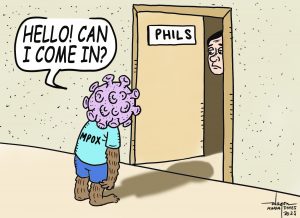By Herman M. Lagon
IT WAS midnight at the PGH (Philippine General Hospital) emergency room triage area, and A Jesuit friend of mine posted, better yet painted, a grim picture on his FB account. Patients, reminiscent of packed sardines, lay in various stages of distress. Some struggled to breathe, others were in deep pain, and the harrowing cries of loved ones echoed off the sterile walls. But amid this chaos, there was a glimmer of hope. On his way back to the chapel, he witnessed fervent prayers, a testament to Filipinos’ unyielding faith and resilience in the face of adversity.
For many, the harrowing scene at PGH is not an anomaly but a glaring reflection of a strained healthcare system. Amidst a public health crisis, one would expect an infusion of funds into emergency rooms. However, the government’s decision to slash budgets contradicts this notion.
While the problem may be more visible at PGH, it is by no means isolated, most especially in the ERs and hallways of the Western Visayas Medical Center (WVMC), WVSU Medical Center, Western Visayas Sanitarium, Corazon Locsin Montelibano Memorial Regional Hospital (CLMMRH), Iloilo Provincial Hospital, Don Jose S. Monfort Medical Center Extension Hospital, Angel Salazar Memorial General Hospital, Roxas Memorial Provincial Hospital, Dr. Rafael S. Tumbokon Memorial Hospital, and Guimaras Provincial Hospital. The lack of pre-hospital care and the high patient influx in the DEMS (Department of Emergency Medicine Services) reflect a systemic problem. A significant number of these patients require immediate attention. However, due to limited resources, the DEMS is forced to rely on conservative medical interventions based on physical findings. That is assuming they have enough health personnel to care for the patients, mostly from low-income families, in dire need.
Such scenarios raise questions on governance. As anthropologist Michael L. Tan aptly points out, the need for “emergency powers” has been frequently invoked to address the nation’s traffic crisis. However, what if this urgency was also channeled towards healthcare? While road congestion remains a tangible problem, the metaphorical congestion of emergency rooms is no less pressing. After all, a bottlenecked road might delay a commuter, but an overwhelmed emergency room could cost a life.
The issue extends beyond just patient care. The lack of privacy and the potential misuse of data in emergency rooms further complicate matters. The PGH might be a public hospital but not a public space. Disseminating unauthorized videos from the ER is not just a breach of trust but also a grave violation of patient rights.
While the prayer “O Lord, as Congress and Senate discuss billions of confidential funds, touch the hearts of our leaders…” is a heartrending plea of my good friend education formator Primo Escobañez, it is also a call to action. While the nation prays for strength and perseverance for its frontline health workers, it is time for a collective introspection. We need to ask–are we doing enough?
This crisis, however, should not be viewed solely as a challenge but as an opportunity for innovation. The rapid rise of e-health hints at a potentially brighter future, with technological solutions easing the burden on physical infrastructure. Moreover, international collaborations could usher in best practices and modern methodologies. We pray that our health system bureaucracy will pay attention to and invest the public’s money.
Emergency rooms, like PGH’s, serve as a mirror, reflecting both the vulnerabilities and strengths of the Philippine healthcare system. While the current scenario is undoubtedly challenging, it is also a clarion call. It calls for holistic reforms, technological integrations, and a reiteration of the nation’s commitment to its people. Ultimately, it is not just about surviving an emergency but building a system that ensures we do not reach that stage in the first place.
***
Doc H fondly describes himself as a ‘student of and for life’ who, like many others, aspires to a life-giving and why-driven world that is grounded in social justice and the pursuit of happiness. His views herewith do not necessarily reflect those of the institutions he is employed or connected with.



